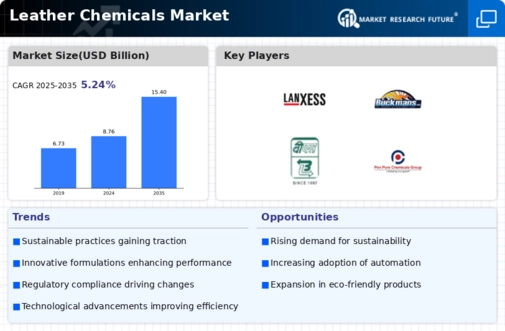Top Industry Leaders in the Leather Chemicals Market

Leather, a material synonymous with luxury and durability, owes its unique properties to a hidden world of chemicals. The leather chemicals market, though often unseen, plays a crucial role in transforming raw hides into supple, vibrant leather used in various products. This dynamic terrain pulsates with competition, where established giants and niche players battle for dominance, shaping the future of this age-old industry.
Strategies Fueling the Fight:
-
Sustainable Prowess: Environmental concerns are shaping the market, with companies like Lanxess and TFL pioneering the development of bio-based tanning agents and chromium-free alternatives. Sustainability is no longer a niche, but a key differentiator for market share. -
Innovation Edge: From water-saving tanning processes to self-healing leather finishes, companies like BASF and Stahl are constantly pushing the boundaries of leather treatment, offering enhanced performance and functionality. -
Regional Focus: Asia Pacific, driven by burgeoning demand for leather goods, is a focal point. Companies are establishing local production facilities and distribution networks to capitalize on this regional boom. -
Product Diversification: Leading players like Dow Chemical are expanding their portfolios beyond traditional tanning chemicals, venturing into specialized finishing agents and additives catering to specific applications like automotive leather and high-performance footwear.
Factors Dictating Market Share:
-
Chemical Type: Beamhouse chemicals for preparing hides and tanning agents for preserving and strengthening leather hold the largest market share. However, the demand for finishing chemicals for enhancing aesthetics and functionality is growing rapidly. -
End-Use Industry: Footwear remains the dominant consumer, followed by furniture and automotive. However, niche applications like medical and luxury goods are offering lucrative opportunities for specialized leather chemicals. -
Regulatory Landscape: Stringent regulations on chromium use and hazardous chemicals are driving the shift towards greener alternatives, impacting production processes and product formulations.
Key Players:
- Stahl Holdings B.V. (The Netherlands)
- Schill+Seilacher GMBH (Germany)
- Lanxess (Germany)
- Pulcra Chemicals GmbH (Germany)
- Sisecam Group (Turkey)
- Buckman (US)
- Silvateam S.p.a (Italy)
- TFL Ledertechnik GmbH (Germany)
- Pidilite Industries Limited (India)
- Balmer Lawrie (India)
- QUIMSER, S.A. (Spain)
- Pon Pure Chemicals(India)
Recent Developments:
January 2023: LANXESS and TotalEnergies collaborated on the supply of bio-circular styrene. Through collaboration with TotalEnergies, the business could provide its clients with sustainably produced raw materials.
June 2022: An environmentally friendly dispersion additive, TEGO Disperse 658, was introduced by Evonik. The newest TEGO dispersion agent in the portfolio is easily biodegradable, which raises the production of pigment and colored coatings' sustainability while still providing formulators with a high-performance profile on par with that of other comparable Evonik goods.
July 2022 – Evonik's recombinant non-animal-derived collagen platform has gone commercial. Produced by the fermentation process, Vecollan® is a highly pure and soluble collagen featuring a triple-helix structure that mimics natural collagen properties and can be used in medical, pharmaceutical, cell culture, tissue and other life science applications.
June 2022 – Evonik recently put on the market its new environmentally friendly dispersing agent called TEGO® Disperse 658. This latest TEGO® dispersant is easily biodegradable thereby making it more sustainable for pigment and colored coatings production while maintaining comparable high-performance characteristics of other Evonik products for formulators.

